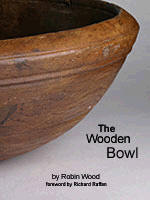

| Publisher | Stobart Davies Ltd. |
| Year | 2005 |
| ISBN | 0-85442-130-0 |
| Pages | 182 |
Esther Heller
I had a bit of spare change weighing down my pocket and treated myself to the above book, ISBN 0-85442-130-0, ordered from http://www.robin-wood.co.uk/book.htm. Not cheap at UKP34.95 to the US (haven't seen the bill yet) but for someone into history or medieval recreation, worth the price, and it showed up in a week in its very own Royal Mail sack (looks like a blue plastic feed sack with plastic bits to hold a string closure) with a very hefty 1/4" wide wire tie like locking device. Inside was a corrugated box that had to be cut off of the bubble pack wrapping the kraft paper covered book. Definitely exceeds packing expectations.
The book has a short set of photos at the end demonstrating turning a porringer, if you want how to turn, get Earnie Conover's bowl book, and the recent Woodwork (Artsy US woodworking mag Jeff) article has a lot more information on his hook tools. But this is a history of turned bowls and cups in the UK with a few mentions elsewhere from pre-history to the present. Lots and lots of pictures with close-ups of the tool marks of a lot of bowls, and a bunch of drawings (for SCA-folk, in the style of the HMSO London series) of the exterior and sections of the bowls. Only thing missing for reproduction is dimensions for a given drawing but he describes the general ranges and a lot of evidence that they made the biggest bowl possible from a given tree trunk.
A number of bowls have facets from the roughing with an axe, and all the "common" bowls have turning marks. Only the high end mazers show evidence of abrasives, any SCAdian needing to document the lack of massive finishing on a utilitarian object will find documentation here. He also has a lovely bibliography, not all in English, pointing where to look for anyone interested in elsewhere in Europe. He claims that from Roman to 17th century the most common eating utensils were wood not pottery and makes a believable case.
Summary: If you want a step by step how to do it, look elsewhere (Conover being one I am familiar with). If you want a large set of artifact documentation, this is your book. If you are in the Society for Creative Anachronism and looking for documentation, this ranks with the HMSO series for wooden bowls and is highly unlikely to be topped for a long time, grab it before it goes out of print. Lots of examples from Anglo-Saxon and medieval through Mary Rose (ship that foundered in 1545 and excavated recently).